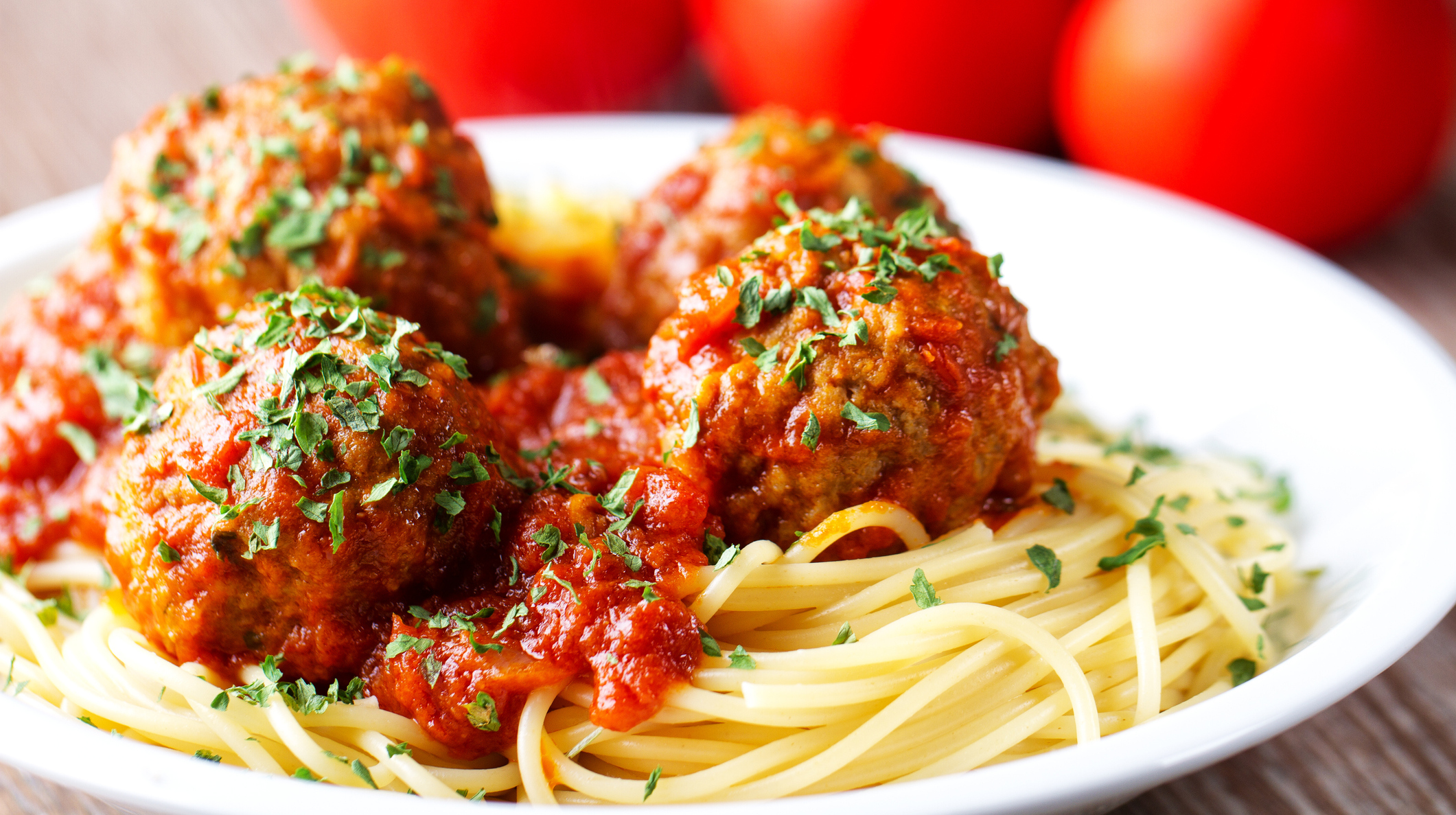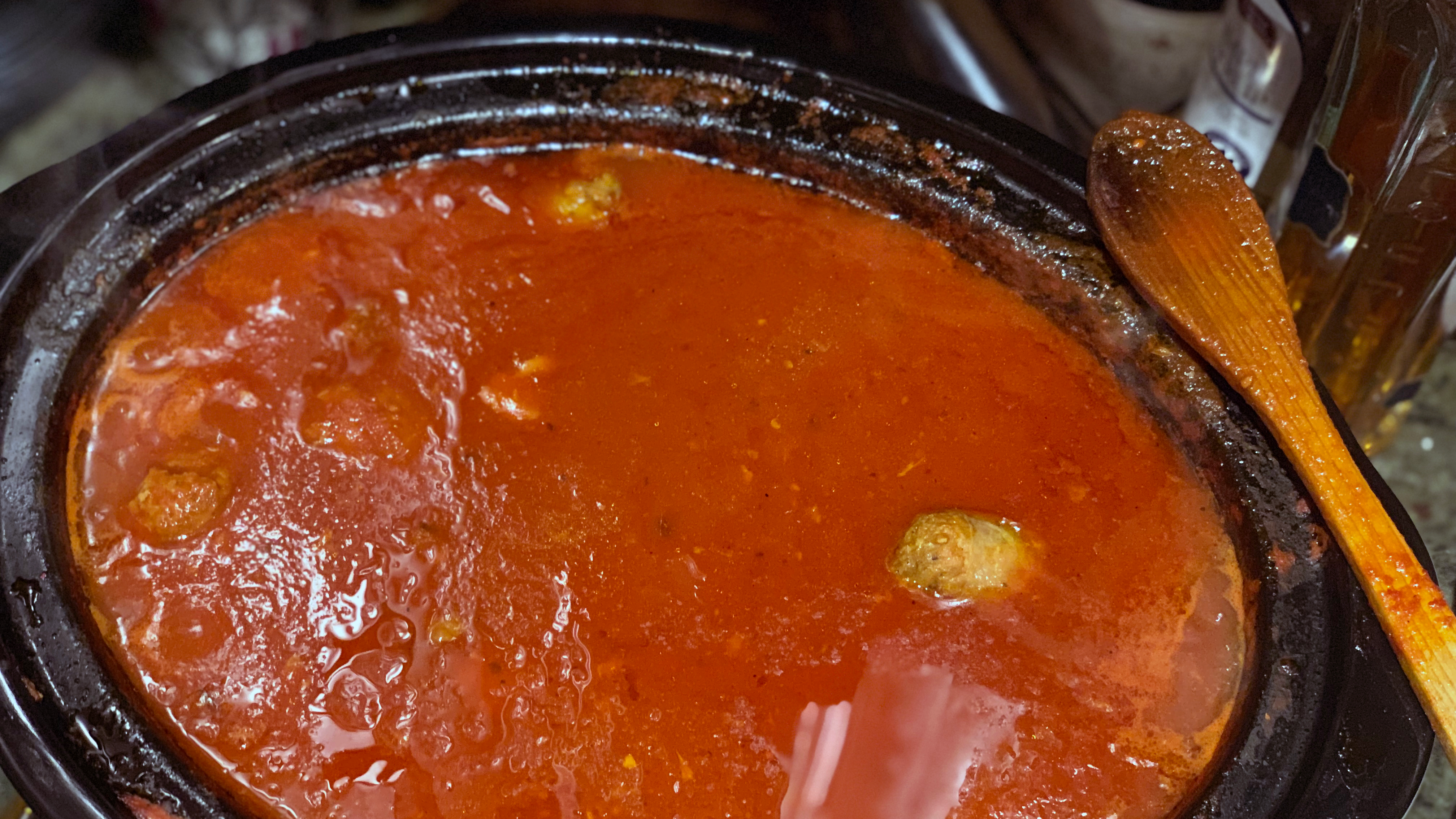How I Learned To Make Sunday Sauce From My Huge Jersey Family
I'm reaching way back to the earliest memories of my youth, to the first pasta accompaniment I ever knew and loved: Sunday sauce. Back then that's not what we called it, at least in my family. It was just sauce. My immediate family wasn't on the "gravy" train—which was odd because that's what my maternal grandmother called it (confusing the hell out of my 4-year-old self). My parents got married young and my mom moved in with my paternal grandparents when my dad was in Vietnam, so my mother ended up adopting my dad's family's Italian-American culinary lingo. People often claim that the gravy-versus-sauce thing is regional, but my family is proof that it's not. Both my paternal and maternal grandparents grew up in Paterson, New Jersey.
Until I was nearly 6 years old, I lived upstairs from my great aunt and great- grandmother and across the street from my dad's parents. Both sets of familial neighbors prepared their own respective Sunday macaroni feasts. We'd often cross the street and join my grandparents for grandma's sauce (still the gold standard), when my mom wasn't making it herself. When we moved about a half-mile away, the Sunday tradition died. My mother would still make the sauce on the weekends, but the finished product would go directly into multiple Tupperware containers and straight into the freezer for future consumption.
Sunday sauce is a completely different beast than marinara or any other tomato-based recipe, mainly due to the time it takes to cook (pretty much all day) and the various meats that stew in it. Meatballs and Italian pork sausage are standard, but beyond that, you can get creative with the additions. My grandmother frequently would include braciole—thin-sliced beef or pork with Parmesan cheese and fresh herbs, rolled up, held together with string and braised in the sauce. My mom had an affinity for pork neck bones, which bring a lot of meaty flavors to the table.
By the time I was 18, I had given up on meat entirely and would, for the next 20 years, make a pale, vegetarian imitation of the real deal. When I finally re-embraced carnivorism, I set out to rediscover true Sunday sauce and ultimately develop my own take on it, incorporating elements from my mother's, grandmother's and assorted cookbook recipes. Even though every version I'd grown up eating—including my own meatless interpretation—included tomato paste, I stopped using it. The sauce does just fine without it and the starch from the pasta provides more than enough thickness. But if you want to use tomato paste, I'd recommend no more than one six-ounce can for every two 28-ounce cans of tomatoes—half the number my mom uses.
On tomatoes
About those cans. Obviously, there's no comparison for fresh plum tomatoes. However, you're likely reading this in a non-August month and the tomatoes at your local supermarket are going to lack in flavor. You need at least 10 pounds of high-quality plum tomatoes to make sauce in any significant quality. Most of the year you're going to want to use canned.
And here comes my predicable endorsement of San Marzano tomatoes. I know some publications have asserted that "San Marzano" is just marketing. I believe that is only partially true. There's a brand on the market called, simply, San Marzano. You might recognize it from its hand-drawn tomatoes on a white background with green trim. That's marketing. These aren't actually San Marzanos. In fact, most of the cans available in the U.S. whose labels read San Marzano are fake. Even some that read "D.O.P."—Italy's protected designation—are fraudulent. Many times the tomatoes are sent to the U.S. in unmarked cans and marketers will add the three letters to it, since they're not bound by Italy's rules. There are a number of ways to spot the genuine article. First of all, the tomatoes have to be whole and peeled. If they're crushed or diced, they already fail. In addition to the D.O.P., look for the Consorzio S. Marzano seal, beneath which will be a certification number (it'll read "No XXXXX").
I didn't grow up with San Marzano tomatoes. To this day, my mom uses the Tuttorosso brand, which are terrific. But I definitely can tell the difference in flavor and consistency. True San Marzano tomatoes practically disintegrate when you touch them, which makes them easy to crush by hand (nowadays I just throw them in my Ninja food processor—I'm lazy like that).
I've also discovered the joy of making sauce in a slow-cooker, which takes about eight hours total. If you do, I advise that during the last hour, you set it to high and remove the lid to allow some residual moisture to evaporate.
On meats
A word on my chosen meats. I've made braciole a couple of times, but it got labor-intensive and somewhat unnecessary considering all of the other, bonier meats I've typically used. The meatballs I make are just as labor-intensive, if not more so, which is why I typically make them in bulk. The amount of sauce I make at one time is enough for that day's dinner, as well as three-to-four additional meals' worth to freeze for later. But I make a good 24 to 26 meatballs from a combined four pounds of ground beef and pork. If it's just my wife and me, we only eat two of those. If it's a dinner party, we'll go through six. We'll freeze the rest, which will find their way into a few more batches of sauce. In every batch, I'll add sausage, beef short ribs and pork spare ribs.
Again, that's my preference. Experiment a little, if you'd like. Use my recipe as a rough guide, but make it your own. By the time you read this, I probably will have tweaked it again anyway.
Jeff’s Sunday Sauce
I contributed this recipe to John Holl's book, Dishing Up New Jersey. It makes a total of 112 ounces of sauce. You'll want to hang on to the extra 20 ounces if guests requests a little more sauce for their meal. You'll also want to keep some of it in the fridge or freezer to add to any leftover baked ziti to make it less dry.
- 20 whole cloves of garlic
- 1/3 cup extra virgin olive oil
- 1 Tbsp. dried red pepper flakes
- 4 cans (28 oz.) whole San Marzano tomatoes
- 2 tsp. sea salt, plus more to taste
- 1 pound bone-in beef short ribs
- 1 pound bone-in pork spare ribs
- 3 links sweet Italian sausage, halved
- 4 meatballs (here's my meatball recipe)
Pour olive oil into large skillet on the stovetop. Over medium heat, add whole cloves of garlic and cook for 6-8 minutes, stirring constantly. Add red pepper flakes and cook for a minute, also stirring constantly. Transfer oil, garlic and pepper flakes into slow cooker.
Add the tomatoes and juice into the slow cooker, using a potato masher to crush and break them apart. Add the sea salt and stir. Turn cooker to low and let cook for four hours. If you want to keep the dish vegetarian, I'd advise just stopping here. At this point you've got a very versatile marinara sauce.
After about 3 1/2 hours, heat a large skillet on the stovetop and, brown the spare ribs, the short ribs, and sausage and set aside, reserving any juices. Add the spare ribs and short ribs to the slow cooker, reserving the sausage.
Cook sauce for an additional 3 1/2 to 4 hours on low, then add meatballs and sausage. Cook for another 60 to 90 minutes. By this point, the short ribs and spare ribs should fall off the bone to become one with the sauce and create a carnivorous symphony.

